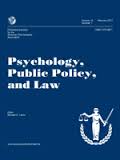Addressing differences in exposure to violence in high risk groups in general and within the life experience of specific, targeted adolescents could both have an impact on reducing involvement in gun violence. This is the bottom line of a recently published article in Law and Human Behavior. Below is a summary of the research and findings as well as a translation of this research into practice.Familiarity in eyewitness identification should be conceptualized on a continuum, and providing expert testimony is the best approach to inform jurors in court on the matter. This is the bottom line of a recently published article in Psychology, Public Policy, and Law. Below is a summary of the research and findings as well as a translation of this research into practice.

Featured Article | Psychology, Public Policy, and Law | 2019, Vol. 25, No. 3, 128–146
Familiar eyewitness identifications: The current state of affairs
Author
Jonathan P. Vallano, University of Pittsburgh at Greensburg
Kristen A. Slapinski, Iowa State University
Lisa J. Steele, Steele and Associates, Shrewsbury, Massachusetts
Abigail P. Briggs, University of Pittsburgh
Joanna D. Pozzulo, Carleton University
Abstract
This article examines “familiar identifications,” or identifications where an eyewitness explicitly states that she has seen the perpetrator before the crime. The first section of this article reviews the literature on familiar identification accuracy. Although these identifications can be of high accuracy they are far from infallible, particularly in cases of minimal prior exposure and poor viewing conditions during the crime. Limitations and areas for future research are discussed. Specifically, we note the ill-defined nature of familiarity within the research and its oft-misleading treatment as a dichotomous construct, and therefore emphasize its continuous nature and recommend more ecologically valid research with “ground truth” data be conducted to examine how its differing degrees interact with other estimator variables. The second section of this article reviews how federal and state courts commonly deal with familiar identifications. The case law reveals that many courts believe any amount of familiarity enhances eyewitness memory and identification accuracy, which sometimes (correctly or incorrectly) lessens concerns over other variables known to lower identification accuracy (e.g., poor viewing conditions, a showup identification procedure). Consequentially, courts sometimes use familiarity to deny motions to suppress eyewitness evidence along with refusing to admit eyewitness experts and jury instructions. We discuss how well courts’ decisions align with the research while providing concrete recommendations for expert witnesses and legal officials in familiar identification cases. Specifically, we argue that claimed familiarity should be examined for its veracity and its effects on identification accuracy be evaluated in relation to other estimator and system variables.
Keywords
familiarity, eyewitness memory, legal decision-making, public policy
Summary of the Research
“In many criminal prosecutions, an eyewitness identification constitutes the sole piece of evidence against a defendant. Despite jurors’ heavy reliance on eyewitness evidence in criminal trials, it is well established that eyewitness memory and identification can be fraught with error. In fact, over 70% of known wrongful convictions established by DNA evidence are due, in part, to eyewitness misidentification.” (p. 128)
“The concerns regarding the reliability of eyewitness evidence have justifiably garnered significant attention from social scientists and legal officials. Yet this interest has primarily centered on circumstances where an eyewitness identifies a perpetrator who she has never seen before the crime. […] In sum, this research robustly illuminates how the reconstructive nature of eyewitness memory can lead to errors in stranger identification cases.” (pp. 128–129)
“Scenarios where an eyewitness explicitly states that she has seen (or known) the perpetrator before the crime—which we now refer to as a familiar identification—represent a substantial percentage of all eyewitness identifications, with field studies estimating from around 10% to as many as 67%. And some of these cases can involve mistaken identifications that result in wrongful convictions.” (p. 129)
“Despite their frequency and importance, familiar identifications have received only sporadic and haphazard attention among social scientists and legal practitioners. Specifically, there is no known cohesive analysis regarding what a familiar identification is, their general accuracy rates, and the factors that affect their reliability. And there is even less systematic documentation regarding how courts make decisions in familiar identification cases, including judges’ admissibility determinations regarding eyewitness evidence and safeguards to presenting potentially unreliable evidence in court such as expert testimony and eyewitness jury instructions. As a result, the present review fills these important voids by synthesizing the relevant research on familiar identifications while reviewing case law to illuminate how courts perceive familiarity and make legal determinations in such cases.” (p. 129)
“Familiar identifications can be very accurate, especially where an eyewitness has had extensive and/or meaningful prior exposure to a personally familiar perpetrator they can clearly view during the crime. Such identifications often occur when an eyewitness immediately informs law enforcement of the perpetrator’s identity, and may involve a subsequent confirmatory identification (e.g., “Is this is the person who shot you?”). These familiar identifications more closely correspond to the extant research indicating high accuracy rates (especially relative to strangers), likely due to more flexible, abstract representations associated with known individuals.” (p. 133)
“Yet familiar identifications are not infallible. First, an eyewitness who states that they know who the perpetrator is does not necessarily mean that the familiar person she identified is the perpetrator. Second, familiar identifications are not all created equal. Familiar identifications involving minimal prior exposure to the perpetrator may operate similarly to stranger identifications, with similarly high error rates. And identifications involving greater—yet not extensive—familiarity (e.g., “I have seen the perpetrator around the neighborhood but cannot recall his name”) and where an individual is later identified from a lineup are of more questionable reliability than an immediate identification of a well-known individual.” (p. 133)
“The reviewed body of research is sufficient to reasonably conclude that familiarity generally enhances eyewitness identification accuracy, especially compared to the identifications of strangers. Although researchers often distinguish familiar from stranger identifications for the sake of simplicity when acknowledging the superior accuracy rates (and potentially different cognitive processes) of the former, familiarity is a continuous construct.” (p. 133)
“Courts have long distinguished between stranger and familiar identifications, often endorsing the belief that familiar identifications have superior accuracy rates. While this solitary belief is generally consistent with the research, it may permit courts to neglect engaging in a more nuanced evaluation of these identifications.” (p. 141)
“Much is known about familiar identifications, showing enhanced (but far from flawless) accuracy rates. Yet much remains unknown. More ecologically valid research with other system and estimator variables is sorely needed to inform expert testimony and improve legal decisions in these cases.” (p. 142)
Translating Research into Practice
“Many familiar and stranger identifications are sufficiently similar whereby certain (but not all) estimator variables similarly harm their reliability. As a result, whether prior exposure occurred—and if so—its quantity (amount) and quality (type), the crime viewing conditions, and the context surrounding the identification should all be considered when evaluating its reliability.” (p. 133)
“Upon learning that an eyewitness “looks familiar,” the inevitable follow-up inquiry should turn to whether prior exposure actually occurred, and if so, to what degree. After all, even if prior exposure occurred, familiarity can be very minimal (e.g., an individual seen once or twice around the neighborhood), which may be much more closely aligned with stranger identifications.” (pp. 133–134)
“We recommend that the type and degree of prior exposure, crime viewing conditions, and circumstances surrounding the identification procedure always be assessed when evaluating familiar identification reliability. And we reiterate the need to explicitly treat familiarity as a continuous construct. After all, the distinction between stranger and familiar identifications often made by researchers can unintentionally mislead courts to misperceive familiarity as dichotomous and lead to the flawed conclusion that all familiar identifications are created equal.” (p. 142)
“Courts sometimes err by giving too much weight to familiarity and deem an identification unassailably reliable, particularly in cases involving minimal prior exposure and/or poor viewing conditions. And assertions of familiarity do not equal actual familiarity and should not be blindly accepted. Therefore, we recommend that courts always evaluate whether prior exposure actually occurred, and if so, to what degree.” (p. 141)
“We further believe that lay knowledge of this research and its conclusions are likely “beyond the ken” of the average juror. Although providing fact-finders with additional guidance in the form of expert testimony and jury instructions are admittedly imperfect options, we believe that expert testimony is the most advantageous option, as it can flexibly update jurors on the current research in “real time.” Otherwise, we are undoubtedly faced with judges, attorneys, and jurors who will be substantially undereducated about this complex subject. […] we discourage the blanket application of factors affecting stranger identification accuracy to familiar identifications, as their impact likely depends upon the degree of familiarity between eyewitness and perpetrator, issues we leave to the expert.” (p. 142)
Other Interesting Tidbits for Researchers and Clinicians
“We believe it is most apt to explicitly conceptualize familiarity on a continuum. This continuum includes different types and degrees of familiarity, ranging from never seen before (stranger) perpetrators to those who have been seen a few times (minimal familiarity—most closely aligned with “casual” familiarity, or individuals seen around the neighborhood), to those who have been seen fairly regularly (moderate familiarity—a regular customer), to those who have been extensively encountered and/or well known (extensive familiarity— coworkers; family and friends. […] the familiarity continuum and associated typology is meant to more accurately characterize familiarity as a continuous construct, illustrate how increasing familiarity generally increases accuracy, and delineate specific points on the familiarity continuum where accuracy rates are most likely to (or actually do) differ to assist researchers and practitioners.” (p. 134)
“We implore future research to craft and test jury instructions specifically designed for familiar identification cases, as this solution would be the most cost-effective and easy-to-implement remedy that could be uniformly applied in all such cases. As a result, we presently believe the better approach is to provide expert testimony in familiar identification cases, as it is the most flexible approach to best educate and disabuse jurors who hold erroneous notions. Yet we recommend researchers to examine its content and efficacy.” (p. 142)
“We emphasize the need for more research to better inform courts’ and jurors’ legal decisions in familiar identification cases. Most importantly, we encourage research on the accuracy of familiar identifications at different gradations (especially more “casual” or “moderate” familiarity) in more ecologically valid settings, particularly as the research can produce different results in varying contexts (e.g., lab or real-world). […] We call for corresponding research on jurors’ perceptions and decisions in familiar identification cases and the effects of the discussed remedies (expert testimony and jury instructions) on jurors’ decisions.” (p. 142)
Join the Discussion
As always, please join the discussion below if you have thoughts or comments to add!







